Icosihexagon
| Regular icosihexagon | |
|---|---|
 A regular icosihexagon | |
| Type | Regular polygon |
| Edges and vertices | 26 |
| Schläfli symbol | {26}, t{13} |
| Coxeter diagram |
|
| Symmetry group | Dihedral (D26), order 2×26 |
| Internal angle (degrees) | ≈166.154° |
| Dual polygon | Self |
| Properties | Convex, cyclic, equilateral, isogonal, isotoxal |
In geometry, an icosihexagon (or icosikaihexagon) or 26-gon is a twenty-six-sided polygon. The sum of any icosihexagon's interior angles is 4320 degrees.
Regular icosihexagon
The regular icosihexagon is represented by Schläfli symbol {26} and can also be constructed as a truncated tridecagon, t{13}.
The area of a regular icosihexagon is: (with t = edge length)
Dissection

Coxeter states that every zonogon (a 2m-gon whose opposite sides are parallel and of equal length) can be dissected into m(m-1)/2 parallelograms. In particular this is true for regular polygons with evenly many sides, in which case the parallelograms are all rhombi. For the regular icosihexagon, m=13, and it can be divided into 78: 6 sets of 13 rhombs. This decomposition is based on a Petrie polygon projection of a 13-cube.[1]
 |
 |
 |
 |
Related polygons
An icosihexagram is a 26-sided star polygon. There are 5 regular forms given by Schläfli symbols: {26/3}, {26/5}, {26/7}, {26/9}, and {26/11}.
 {26/3} |
 {26/5} |
 {26/7} |
 {26/9} |
 {26/11} |
There are also isogonal icosihexagrams constructed as deeper truncations of the regular tridecagon {13} and tridecagrams {13/2}, {13/3}, {13/4}, {13/5} and {13/6}.[2]
| Isogonal truncations of regular tridecagon and tridecagrams | |||||||||||
|---|---|---|---|---|---|---|---|---|---|---|---|
| Quasiregular | Isogonal | Quasiregular | |||||||||
 t{13} = {26} |
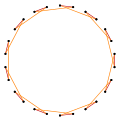 |
 |
 |
 |
 |
 |
 t{13/12}={26/12} | ||||
 t{13/2}={26/2} |
 |
 |
 |
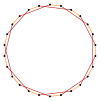 |
 |
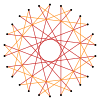 |
 t{13/11}={26/11} | ||||
 t{13/3} = {26/3} |
 |
 |
 |
 |
 |
 |
 t{13/10}={26/10} | ||||
 t{13/4}={26/4} |
 |
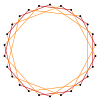 |
 |
 |
 |
 |
 t{13/9}={26/9} | ||||
 t{13/5} = {26/5} |
 |
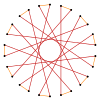 |
 |
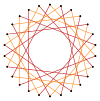 |
 |
 |
 t{13/8}={26/8} | ||||
 t{13/6}={26/6} |
 |
 |
 |
 |
 |
 |
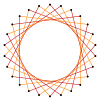 t{13/7}={26/7} | ||||
References
- ↑ Coxeter, Mathematical recreations and Essays, Thirteenth edition, p.141
- ↑ The Lighter Side of Mathematics: Proceedings of the Eugène Strens Memorial Conference on Recreational Mathematics and its History, (1994), Metamorphoses of polygons, Branko Grünbaum